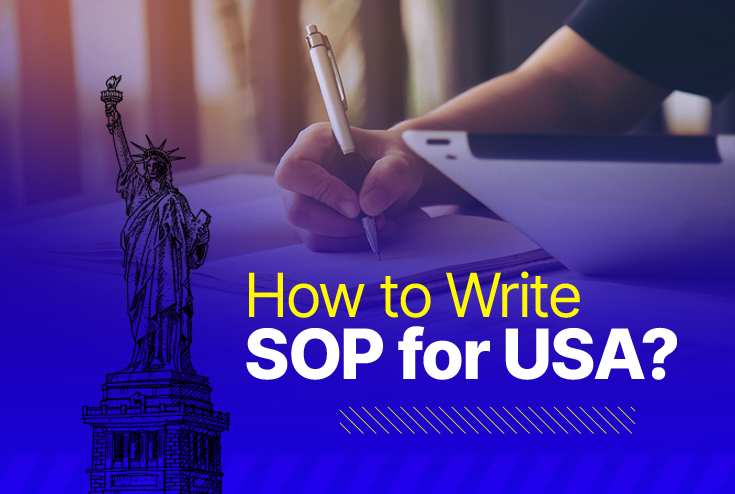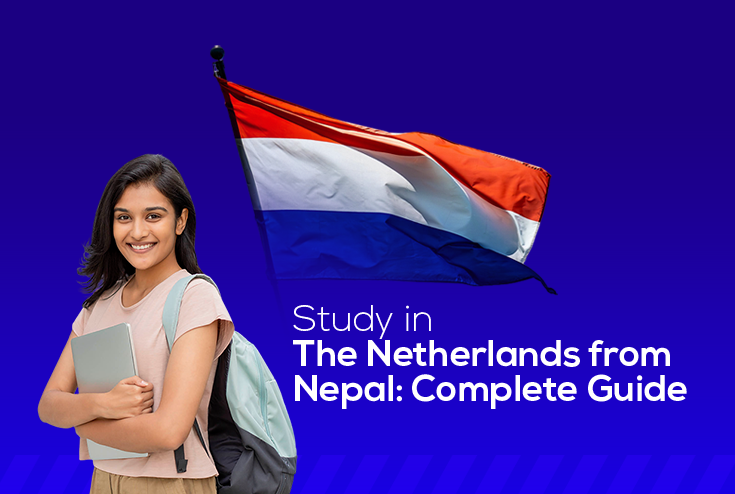
SOP for US Universities: Format, Tips & Sample
Are you planning to pursue your higher studies in the USA? Then, you must have come across a very crucial document in your application checklist: the Statement of Purpose (SOP). In this blog, we will provide you with step-by-step guidance on how to write an effective SOP to boost your chances of admission into US universities.
Table of Contents
- What is the Statement of Purpose (SOP)?
- Why is SOP Important for U.S. Universities?
- SOP Format for the USA: How to Write an SOP in 2025?
- Introduction (Hook and Motivation)
- Academic Background
- Professional Experience (If Applicable)
- Why This Program?
- Why the USA?
- Why This University?
- Career Goals (Short-term and Long-term Plans)
- Conclusion (Reaffirmation and Thank You)
- SOP for Different Levels of Study
- Sample SOP for a USA Student Visa (2025)
- Tips to Make Your SOP for USA Stand Out
- Common Mistakes to Avoid While Writing SOP for USA
- Conclusion
- FAQs - SOP for U.S. Universities
What is the Statement of Purpose (SOP)?
A Statement of Purpose (SOP) is a formal, structured essay required by universities and colleges especially in countries like the United States, Canada, Australia, and others as a part of the admission application.
In the SOP, the applicant explains their:
- Academic background
- Professional experience (if any)
- Reasons for choosing a particular program
- Motivation for choosing a specific university
- Reasons for choosing the particular country
- Future academic and career goals
The SOP is not just a summary of your resume or academic achievements, it is your opportunity to present your story, demonstrate your vision, and show how the program will help you achieve your career goals.
Key Characteristics of an SOP:
- Personal: It should reflect your unique vision and journey.
- Structured: It should follow a logical flow from past to future.
- Focused: Stay relevant to your field of study and career goals.
- Professional: Use formal tone, correct grammar, and a clear style.
- Custom-Tailored: Should be specific to the course and university you’re applying to.
Need of SOP for U.S. Universities?
U.S. universities take a holistic approach to admissions. This means they don't just look at grades and test scores but they also evaluate your personal motivations, commitment, and potential. That’s why the Statement of Purpose plays a critical role.
Here’s why the SOP is important:
1. Explains Your Academic and Career Goals
The SOP helps the admission committee understand:
- Why you want to study a specific subject
- What excites you about it
- Where you want to go with your degree
Example: A student pursuing Data Science might explain how real-world data analytics problems in Nepal inspired them to learn how to build scalable, AI-based solutions.
2. Reveals Your Thought Process and Critical Thinking
Unlike grades or certificates, the SOP reflects your:
- Writing ability
- Clarity of thought
- Logical reasoning
- Creativity in connecting past experiences to future goals
Why this matters: U.S. universities want students who can think independently and communicate effectively - skills critical for academic and professional success.
3. Shows Your Fit for the Program and University
Admissions officers look for alignment between:
- Your interests and the university’s academic strengths
- Your goals and what the program offers
When you mention specific faculty, labs, courses, or research groups, it shows you’ve done your homework and are genuinely interested.
4. Reflects Your Global Outlook
U.S. universities value international diversity. Your SOP should:
- Highlight your unique perspective as a Nepali or international student
- Explain how your background contributes to a global academic community
5. Compensates for Weaknesses in Your Profile
If you have a low GPA, study gap, or backlogs, a well-written SOP gives you a chance to:
- Explain what happened
- Show how you’ve grown since then
- Emphasize strengths and achievements
6. Essential for Scholarships and Assistantships
In some cases, SOPs are used to:
- Evaluate your seriousness as a candidate
- Decide on research assistantships, teaching roles, or funding
A goal-driven, sincere SOP can significantly improve your chances of receiving financial aid.
7. Gives Insight into Your Career Vision
U.S. universities aim to admit students who will contribute to society, research, and industry. A clear SOP with:
- Defined short and long-term goals
- Passion for innovation or problem-solving
- Commitment to community or global issues helps them see your potential impact.
Your Statement of Purpose is your academic autobiography. It provides depth and context to your application and allows you to communicate with the admission committee on a personal level. A well-written SOP can:
- Secure admission to your dream U.S. university
- Improve your scholarship and funding opportunities
- Make your application stand out from the competition
SOP Format for the USA: How to Write an SOP in 2025?
A well-formatted and structured SOP is very crucial for your application. Here is a step by step guide to write a SOP:
1. Introduction (Hook and Motivation)
Purpose: Grab the attention of the reader and clearly state your passion for the chosen field of study.
Length: 1 paragraph
What to include:
- A personal story, life experience, or moment that sparked your academic interest
- The field you want to pursue
- A powerful opening that leads naturally into your academic background
Example:
“While growing up in a remote village in Nepal, I often saw patients travel miles for medical help. This ignited my interest in using technology to make healthcare more accessible, leading me to pursue a career in Biomedical Engineering.”
2. Academic Background
Purpose: Show that you have the educational foundation for the program you are applying to.
Length: 1-2 paragraphs
What to include:
- Your previous degrees (Bachelor’s, high school, etc.)
- Relevant coursework, academic achievements, and projects
- Specific skills or subjects that align with your chosen program
- Challenges you’ve overcome in your academic journey (if any)
Example:
“I completed my Bachelor’s in Information Technology from ABC College with a focus on data analysis and AI tools. My capstone project focused on developing a chatbot using NLP for university FAQs, which sparked my interest in human-computer interaction.”
3. Professional Experience (If Applicable)
Purpose: Demonstrate real-world application of your skills and how it influenced your decision to pursue further education.
Length: 1 paragraph
What to include:
- Internships, job roles, or freelance work
- Technical tools, platforms, or achievements
- Any leadership or teamwork experience
- How your job experience influenced your academic or career path
Example:
“Working as an SEO and content marketing intern taught me the power of data in decision-making. This exposure to analytics motivated me to deepen my understanding through a Master’s in Data Science.”
4. Why This Program?
Purpose: Explain why this specific course aligns with your goals.
Length: 1 paragraph
What to include:
- Subjects, modules, or skills you’re interested in
- How the course matches your previous knowledge
- Specific technologies, theories, or methodologies you want to learn
Example:
“The MS in Data Science program at your university, with core modules in Machine Learning, Data Mining, and Big Data Architecture, perfectly matches my ambition to become a data-driven problem solver.”
5. Why the USA?
Purpose: Show your basis for choosing the United States over other countries.
Length: 1 paragraph
What to include:
- The innovation ecosystem in the U.S.
- Diverse academic environment
- Research opportunities, global exposure
- Career prospects and post-study work options
Example:
“The USA’s reputation for cutting-edge research, its industry-academic partnerships, and the flexible learning structure make it the ideal destination for pursuing my Master’s.”
6. Why This University?
Purpose: Demonstrate you've researched the university and see it as the best fit.
Length: 1 paragraph
What to include:
- Faculty members you want to work with
- Research labs or centers of interest
- Facilities or specific university values you admire
- Past alumni achievements or rankings (briefly)
Example:
“The Center for Artificial Intelligence Research at XYZ University, under the guidance of Prof. [Name], is closely aligned with my interest in neural networks and AI ethics. I am particularly excited about your collaboration with Google Research.”
7. Career Goals (Short-term and Long-term Plans)
Purpose: Show you have a clear vision for your future, and the program is a step toward it.
Length: 1-2 paragraphs
What to include:
- Short-term goals: e.g., working in a U.S. tech firm, pursuing research, gaining industrial exposure
- Long-term goals: e.g., returning to Nepal to work on development projects, launching your own startup, pursuing a PhD Align your goals with your field and course
Example:
“In the short term, I aim to work in data science teams in Silicon Valley to gain real-world experience. In the long run, I plan to return to Nepal and build AI solutions to enhance public services and education systems.”
8. Conclusion (Reaffirmation and Thank You)
Purpose: End on a confident and positive note.
Length: 1 paragraph
What to include:
- Reaffirm your interest in the program
- Mention your enthusiasm for learning and contribution
- Express gratitude
Example:
“I am confident that the academic environment and research opportunities at your university will allow me to thrive. I look forward to contributing to your diverse student community while pursuing my personal and professional goals. Thank you for considering my application.”
SOP for Different Levels of Study in USA
|
Level |
What to Emphasize? |
|---|---|
|
Bachelor’s |
Personal motivation, academic performance, extracurriculars |
|
Master’s (Taught) |
Academic background, work experience, goals |
|
Master’s (Research) |
Research interest, publications, faculty |
|
PhD |
Research proposal, long-term vision, professor alignment |
Sample SOP for a USA Student Visa (2025)
Below is a sample SOP for studying Master of Computational Data Science at Carnegie Mellon University. You can use this as a reference to write a SOP tailored to your academic and personal circumstances.
Introduction: Personal Motivation
From predicting monsoon patterns that affect farmers in rural Nepal to optimizing e-commerce user behavior through machine learning, data has always fascinated me not only as numbers but as stories waiting to be told. My journey into Data Science began with a simple question: Can data improve lives in a measurable way? Over time, that question has turned into a passion, one that I am eager to pursue at Carnegie Mellon University, where innovation, research, and real-world impact intersect.
Academic Background
I earned my Bachelor’s degree in [Your Majors] from [Your University Name], graduating among the top 10% of my class. The interdisciplinary nature of the program allowed me to explore key areas including data structures, statistical modeling, databases, and artificial intelligence. Courses such as Probability and Statistics, Data Mining, and Machine Learning built my foundational understanding of data-driven problem solving.
In my final year, I led a capstone project titled “Predicting Mental Health Trends Using Social Media Text Mining” (example), where we analyzed Twitter data using Python, scikit-learn, and sentiment analysis techniques. We successfully modeled anxiety levels based on tweet frequency and content, a project that was presented at our university's annual tech symposium.
Technical & Research Experience
To strengthen my research profile, I undertook a [relevant training or internship], where I collaborated with a team [your learnings and responsibilities]. These experiences gave me confidence in handling real-world, unstructured datasets and fueled my desire to build scalable, intelligent systems powered by data.
Professional Experience
After graduation, I joined [Company Name], a tech startup focused on retail analytics, where I currently work as a Data Analyst. My primary role involves designing ETL pipelines and building dashboards to help retailers forecast inventory using time-series models. Working on large datasets in AWS environments using Spark and Redshift helped me realize the challenges and opportunities in scalable data systems. The intersection of data engineering and machine learning intrigued me, and I now seek to refine these skills through graduate-level study.
Why Master of Computational Data Science at Carnegie Mellon University?
CMU’s MCDS program stands out not only for its interdisciplinary curriculum but also for its deep integration of systems, algorithms, and real-world applications. The Intelligent Systems specialization aligns closely with my interests in large-scale machine learning and decision-making systems. I am particularly excited by courses such as:
- Machine Learning for Large-Scale
- Data Analytics
- Cloud Computing and Big Data
- Interactive Data Science Systems
The opportunity to work with faculty such as [Prof. xxxx], whose work in scalable machine learning systems I have long admired, is another key reason for choosing CMU. Additionally, CMU’s Data Systems Lab and its ongoing projects in distributed data analytics and stream processing directly align with my goals.
Why the USA?
The U.S. is home to some of the world’s most dynamic research and innovation ecosystems in data science. The culture of academic freedom, interdisciplinary collaboration, and cutting-edge research makes it the ideal environment for my graduate studies. Moreover, the opportunity to interact with diverse global talent and industry leaders will help me evolve as both a technologist and a critical thinker. [Include more details through research about U.S. education system]
Career Goals
My short-term goal is to join a top technology firm or research center in the U.S., contributing to projects focused on ethical AI, predictive analytics, and scalable data systems. I aim to specialize in real-time machine learning applications, such as recommender systems and personalized healthcare models.
In the long term, I envision returning to Nepal to contribute to the digital transformation of public systems—particularly in health and education—through data science. I also aspire to establish a data innovation hub in Nepal that can mentor young data enthusiasts and build sustainable solutions for local problems using global technologies.
[Include job prospects and career opportunities in Nepal in details and link with your career plan]
Conclusion
My academic foundation, hands-on experience, and passion for data-driven solutions have led me to pursue the Master of Computational Data Science at Carnegie Mellon University. I am confident that CMU’s rigorous academic environment, innovative research culture, and entrepreneurial spirit will equip me with the skills needed to become a world-class data scientist. I look forward to contributing to CMU’s vibrant learning community and to shaping the future of data science with a strong ethical and social perspective.
Thank you for considering my application.
Note: Make sure to thoroughly research about your course, university and the U.S. education system. Also, demonstrate the job prospects and career opportunities that a graduate in your field of study will receive in Nepal and how you will utilize your degree to uplift Nepal's social and economic development.
Tips to Make Your SOP for USA Stand Out
- Be original: Avoid cliches and copied content.
- Stay relevant: Focus on your academic journey and goals.
- Be honest: Don’t exaggerate skills or achievements.
- Proofread: Check grammar and flow. A single error can ruin your impression.
- Avoid redundancy: Each paragraph should add new value.
Common Mistakes to Avoid While Writing SOP for USA
- Vague goals: Shows lack of direction
- Overly technical jargon: Confuses non-specialist readers
- Flattery towards the university: Sounds insincere
- Repeating the resume: Misses personal reflection
- Irrelevant stories: Wastes limited word space
Conclusion
Writing a compelling Statement of Purpose (SOP) for the USA is more than a formality, it's your personal pitch to the admissions committee. It’s your chance to go beyond test scores and transcripts and tell the story that connects your past, present, and future. A well-crafted SOP can significantly influence your admission chances, scholarship opportunities, and even post-study career paths.
At Dikshya International, we help Nepali students like you build strong SOPs that reflect their true potential and passion. With expert one-on-one guidance, and university-specific insights, we can help you secure admission in your desired university and help you with overall admission procedures and visa guidance to make your dream of studying in the USA a success.
Contact Us Now if you are interested in pursuing your higher studies in the USA!
FAQs - How to Write an SOP for USA
1. How do I start writing my SOP?
Start with a compelling personal story, experience, or motivation that led you to choose your field of study. This creates a strong first impression and sets the tone for the rest of the SOP.
2. How to write SOP step by step?
You may use this structured format below:
- Introduction – Your motivation and background
- Academic Background – Relevant education and achievements
- Work/Project Experience – Internships, jobs, or research
- Why This Program & University – Show alignment and research
- Why the USA – Justify your country choice
- Career Goals – Short and long-term plans
- Conclusion – Summarize your intent and passion
3. How do I introduce myself in a SOP?
Begin with a short personal story or experience that sparked your interest in the field; avoid listing your name or background like a CV. Keep it authentic and engaging.
4. How long should a SOP be for the USA?
Typically, 800 to 1,000 words or 1 to 1.5 pages. Always follow specific university guidelines if provided.
5. Can I write SOP in one day?
Technically yes, but it’s not recommended. A strong SOP needs brainstorming, drafting, editing, and proofreading over several days to reflect quality and clarity.
6. What is the format of SOP in the USA?
Use a formal tone, 4 to 6 well-structured paragraphs, left-aligned text, 11 to 12pt font, and clear sectioning with logical flow.
Also Read:
Study Master’s in USA from Nepal: A 2025 Guide
PhD in USA for Nepalese Students
Best Consultancy in Nepal for USA in 2025: A Guide





Get Guidance